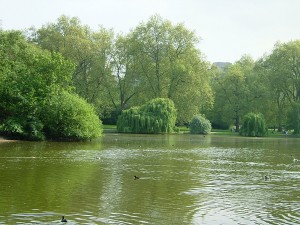A few days ago, I took a stroll through one of London’s finest acres of greenery, St. James Park. As to be expected with any of London’s parks, St. James was gorgeous. A quintessentially English garden, St. James consists overgrown grasses, a long serpentine lake and plentiful randomized outcroppings of shrubs, bushes and trees in place of bright flowers and orderly manicured rows of plants typical of the English picturesque movement of the late 18th Century.
Typically, gardens of the latter variety exist on the continent, where gardens, such as the famous gardens of Versailles and many others, exhibit the ornate, extravagant qualities of brightly coloured flowers placed in neat rows and circles. The picturesque movement moved away from this doctrine and is seen throughout St. James. In the park’s overgrown grasses and serpentine lake, a random, natural effect is created emblemizing the picturesque’s primary goal of replicating nature; an upholding of nature’s wilderness and natural beauty over the patterns and uniformity of continental gardens.
This is not to say, however, that St. James is not just as meticulously groomed as the gardens of Versailles. St. James random look intended to replicate nature is neither easily accomplished nor maintained. Countless effort goes into St. James Park by its numerous caretakers, as is true with all English gardens. At the entrance to every one of London’s parks or green squares, there is a key to the garden demonstrating precisely the garden architect’s intent for the park and which areas contain which types of greenery.
However, there is a sense of hypocrisy to the picturesque. With the effort that goes into making the park look natural, it is still a manmade area and not even the most gifted of garden architects can escape that fact. St. James’ long winding serpentine lake may appear natural, but if one looks at the banks, they would see the concrete walls that enclose it, blatantly marking it an object of man’s creation.
Perhaps the picturesque quality of St. James and countless other gardens, both public and at the homes of the English, is another example of Kate Fox’s English hypocrisy. The English seem to enjoy the idea of walking amidst untouched nature and seem willing to ignore the fact that their parks are endlessly manicured to achieve its natural look. Either way, after spending a glorious afternoon within the park’s beautiful acres, I’m not complaining.

1 response so far ↓
bowmanc // Sep 14th 2010 at 20:03
Luke – I really like your point about hypocrisy in the park because it’s manmade. Pretty cool (well, actually pretty lame) how hypocrisy influences the parks as well. I’d be interested to see how prevalent man-made parks are in America.
You must log in to post a comment.